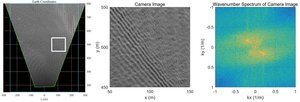Major Research Coastal disaster monitoring with 4K cameras and analysis of related big data
The fierce sea winds caused by Typhoon Faxai in 2019 caused the highest waves ever officially recorded in Tokyo Bay, leaving the coastal areas near Yokohama Port severely damaged by destroying many coastal structures and flooding the hinterland. Real-time confirmation of high-definition surveillance camera images contributes to the identification of disaster areas and early restoration. In addition, understanding the oceanographic conditions at the time of the disaster through post-disaster analysis is an effective research method for clarifying the causes of the disasters. With the rapid spread of 4K cameras in the broadcasting, and medical fields, and etc., although technological innovation is also progressing in the field of surveillance and security cameras, the following two essential criteria must be met for such cameras to be used for the prevention and mitigation of coastal disasters: 1) High-pixel camera to capture wave phenomena; and 2) all-weather type, capable of taking pictures at night and during storms. Recent innovative technological developments in CMOS sensors are clearing these conditions, and their potential for use in coastal disaster prevention is rapidly increasing. Based on this technological trend, this research project aims to develop a unique monitoring system that utilizes 4K cameras, so that eventually the coastal surveillance data that will be obtained through the system, including footage of port facilities, can be shared with relevant government agencies and used for disaster prevention and mitigation. As for the project activities conducted so far, we developed a real-time
coastal disaster surveillance system integrating high-definition 4K IP cameras (image resolution: 3840×2160, 15 fps continuous recording, night photography-enabled) and deployed it on multiple locations to obtain related big data. We then used the ocean surface luminance spectrum discerned from the obtained 4K video data to estimate corresponding 2-D wave number vectors and succeeded in computing the wave directions. As we have also been developing an algorithm for estimating wave statistics, if we could infer wider-ranging wave statistics with it, they could become novel means of wave observation. The 4K-camera system that we have established can be installed at any coastal location that has a platform available. Therefore, if we could share the big data obtained through the system with regional municipalities and other concerned parties, it would be aid their disaster mitigation and elucidate the causes of any disasters they experience.

4K camera images captured at the Kannonzaki radar facility and ocean surface luminance spectrum estimation



